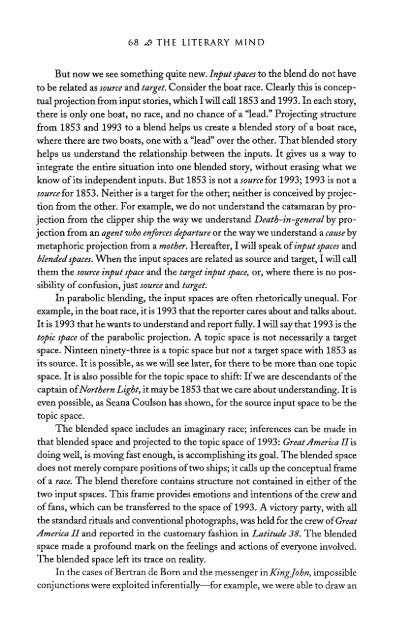The Literary Mind.pdf
The Literary Mind.pdf
The Literary Mind.pdf
Create successful ePaper yourself
Turn your PDF publications into a flip-book with our unique Google optimized e-Paper software.
68 THE LITERARY MIND<br />
But now we see something quite new. Input spaces to the blend do not have<br />
to be related as source and target. Consider the boat race. Clearly this is conceptual<br />
projection from input stories, which I will call 1853 and 1993. In each story,<br />
there is only one boat, no race, and no chance of a "lead." Projecting structure<br />
from 1853 and 1993 to a blend helps us create a blended story of a boat race,<br />
where there are two boats, one with a "lead" over the other. That blended story<br />
helps us understand the relationship between the inputs. It gives us a way to<br />
integrate the entire situation into one blended story, without erasing what we<br />
know of its independent inputs. But 1853 is not a source for 1993; 1993 is not a<br />
source for 1853. Neither is a target for the other; neither is conceived by projection<br />
from the other. For example, we do not understand the catamaran by projection<br />
from the clipper ship the way we understand Death-in-general by projection<br />
from an agent who enforces departure or the way we understand a cause by<br />
metaphoric projection from a mother. Hereafter, I will speak of input spaces and<br />
blended spaces. When the input spaces are related as source and target, I will call<br />
them the source input space and the target input space, or, where there is no possibility<br />
of confusion, just source and target.<br />
In parabolic blending, the input spaces are often rhetorically unequal. For<br />
example, in the boat race, it is 1993 that the reporter cares about and talks about.<br />
It is 1993 that he wants to understand and report fully. I will say that 1993 is the<br />
topic space of the parabolic projection. A topic space is not necessarily a target<br />
space. Ninteen ninety-three is a topic space but not a target space with 1853 as<br />
its source. It is possible, as we will see later, for there to be more than one topic<br />
space. It is also possible for the topic space to shift: If we are descendants of the<br />
captain of Northern Light, it may be 1853 that we care about understanding. It is<br />
even possible, as Seana Coulson has shown, for the source input space to be the<br />
topic space.<br />
<strong>The</strong> blended space includes an imaginary race; inferences can be made in<br />
that blended space and projected to the topic space of 1993: Great America II is<br />
doing well, is moving fast enough, is accomplishing its goal. <strong>The</strong> blended space<br />
does not merely compare positions of two ships; it calls up the conceptual frame<br />
of a race. <strong>The</strong> blend therefore contains structure not contained in either of the<br />
two input spaces. This frame provides emotions and intentions of the crew and<br />
of fans, which can be transferred to the space of 1993. A victory party, with all<br />
the standard rituals and conventional photographs, was held for the crew of Great<br />
America II and reported in the customary fashion in Latitude 38. <strong>The</strong> blended<br />
space made a profound mark on the feelings and actions of everyone involved.<br />
<strong>The</strong> blended space left its trace on reality.<br />
In the cases of Bertran de Born and the messenger in King Johny impossible<br />
conjunctions were exploited inferentially—for example, we were able to draw an















